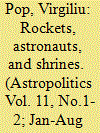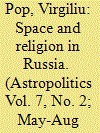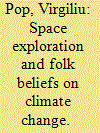| Srl | Item |
| 1 |
ID:
122529


|
|
|
|
|
| Publication |
2013.
|
| Summary/Abstract |
This article examines the relationship between space exploration and sacred visual art, demonstrating that religious iconography and church architecture evolved by assimilating humankind's entry into the physical heavens as a living parable. This is proven by the presence of space exploration imagery within places of worship-from a church building inspired by a payload fairing to inclusion of space exploration milestones as historical landmarks, from astronauts being chosen as depictions of Christian virtues to lunar material being included in church windows, and from a space shuttle being painted on a Christian Orthodox church wall to a space hotel being represented on a Buddhist temple. The incidences of space themes in religious visual arts, as well as the fervor of reception, vary nonetheless among denominations.
|
|
|
|
|
|
|
|
|
|
|
|
|
|
|
|
| 2 |
ID:
090001


|
|
|
|
|
| Publication |
2009.
|
| Summary/Abstract |
This article follows the evolution of the relationship between the Russian space program and spirituality from an astrosociological perspective. It demonstrates that the Russian space program has its roots in Nikolai Fedorov's Cosmism, which envisaged the technological resurrection of the dead and space colonization, and in Marxism, which used space exploration as a means of proving atheism. Whereas the conquest of space has been perceived throughout the world in an ambivalent way, either as an act endorsed by Divinity or as a blasphemous feat, the Soviets took pride in reinventing the "Tower of Babel" in order to "make a name for themselves" and dethrone God (Genesis 11:4). Moreover, the technological miracles of spaceflight and the worship of Yuri Gagarin support the view that Soviet Communism was a state religion. After the fall of the Soviet Union, Orthodox Christianity brought its own contribution to the Russian space program. It will be also shown that, even during the Soviet period, appearances contrasted with the feelings of many of the cosmonauts.
|
|
|
|
|
|
|
|
|
|
|
|
|
|
|
|
| 3 |
ID:
103928


|
|
|
|
|
| Publication |
2011.
|
| Summary/Abstract |
This article surveys a series of folk beliefs of currency at the time of the Apollo missions, that link space exploration with disastrous events occurring at the same time. Floods, droughts, earthquakes and conjunctivitis-all were blamed, by people pertaining to very different cultures, on the actions of reckless astronauts who irked the Divinity or disturbed the celestial mechanics. As will become evident, these folk beliefs fit an existing pattern explainable in the context of "cultural lag" and "future shock." These social phenomena are common to sociology, and when referring to the context of outer space, fall under the purview of astrosociology.
|
|
|
|
|
|
|
|
|
|
|
|
|
|
|
|